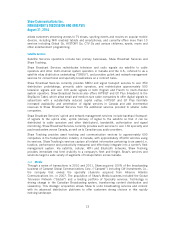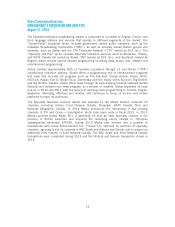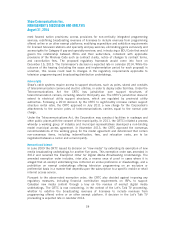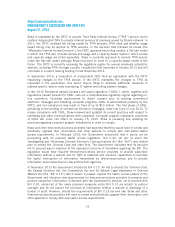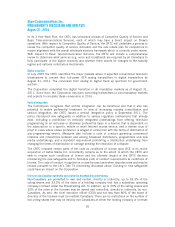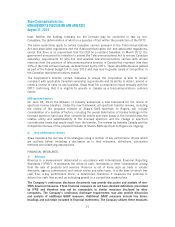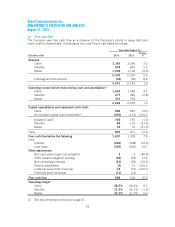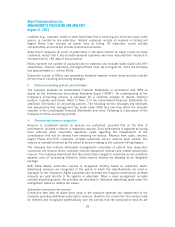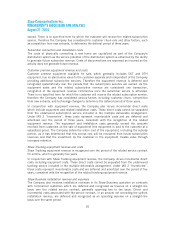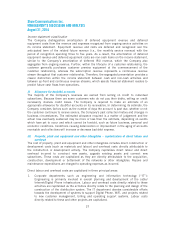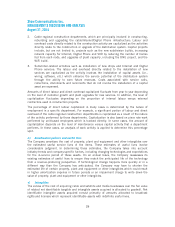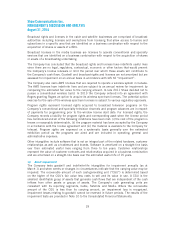Shaw 2014 Annual Report Download - page 24
Download and view the complete annual report
Please find page 24 of the 2014 Shaw annual report below. You can navigate through the pages in the report by either clicking on the pages listed below, or by using the keyword search tool below to find specific information within the annual report.Shaw Communications Inc.
MANAGEMENT’S DISCUSSION AND ANALYSIS
August 31, 2014
In its 3 Year Work Plan, the CRTC has scheduled reviews of Competitor Quality of Service and
Basic Telecommunications Services, each of which may have a direct impact on Shaw’s
operations. With respect to Competitor Quality of Service, the CRTC will undertake a process to
review the competitor quality of service indicators and the rate rebate plan for competitors to
ensure alignment with the overall wholesale services framework which is currently under review.
With respect to Basic Telecommunication Services, the CRTC will initiate a comprehensive
review to determine what services (e.g. voice and broadband) are required by all Canadians to
fully participate in the digital economy and whether there should be changes to the subsidy
regime and national contribution mechanism.
Digital transition
In July 2009 the CRTC identified the major markets where it expected conventional television
broadcasters to convert their full-power OTA analog transmitters to digital transmitters by
August 31, 2011. The conversion from analog to digital freed up spectrum for government
auction.
The Corporation completed the digital transition in all mandatory markets as of August 31,
2011. Since then, the Corporation has been converting transmitters in non-mandatory markets
and expects to complete these conversions in 2016.
Vertical integration
The Commission recognizes that vertical integration can be beneficial and that it also has
potential to enable preferential treatment. In view of increasing industry consolidation and
vertical integration, the CRTC issued a vertical integration policy in September 2011. The
policy introduced new safeguards in addition to various regulatory mechanisms that already
exist, including a prohibition on vertically integrated undertakings from offering television
programming on an exclusive or otherwise preferential basis in a manner that is dependent on
the subscription to a specific mobile or retail Internet access service, and a reverse onus of
proof in cases where undue preference is alleged in connection with the terms of distribution of
any programming service. Measures also include a code of conduct governing commercial
relations and interactions between and among broadcast distributors, programmers and new
media undertakings, and a standstill requirement prohibiting a distribution undertaking from
changing the terms of distribution or carriage pending the resolution of a dispute.
The CRTC imposed certain parts of the code as conditions of license upon BCE in its recent
acquisition of Astral Media Inc. Uncertainty remains as to the extent to which the CRTC will
seek to impose such conditions of licence and the ultimate impact of the CRTC decision
introducing the new safeguards and to formalize code of conduct requirements as conditions of
license. The code of conduct is applied on a case-by-case basis when disputes arise and may be
revised pursuant to the Let’s Talk TV proceeding discussed above. Existing or new safeguards
could have an impact on the Corporation.
Limits on non-Canadian ownership and control for broadcasting undertakings
Non-Canadians are permitted to own and control, directly or indirectly, up to 33.3% of the
voting shares and 33.3% of the votes of a holding company that has a subsidiary operating
company licensed under the Broadcasting Act. In addition, up to 20% of the voting shares and
20% of the votes of the licensee may be owned and controlled, directly or indirectly, by non-
Canadians. As well, the chief executive officer (CEO) and not less than 80% of the board of
directors of the licensee must be resident Canadians. There are no restrictions on the number of
non-voting shares that may be held by non-Canadians at either the holding company or licensee
20




